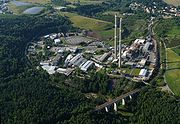Ore Mountain Mining Region
| UNESCO World Heritage Site | |
|---|---|
| Location | Czech Republic and Germany |
| Criteria | Cultural: (ii), (iii), (iv) |
| Reference | 1478 |
| Inscription | 2019 (43rd Session) |
| Area | 6,766.057 ha (16,719.29 acres) |
| Buffer zone | 13,017.791 ha (32,167.66 acres) |
| Coordinates | 50°24′23.5″N 12°50′14.44″E / 50.406528°N 12.8373444°E |
The Ore Mountain Mining Region (German: Montanregion Erzgebirge) is an industrial heritage landscape, over 800 years old, in the border region between the German state of Saxony and North Bohemia in the Czech Republic. It is characterised by a plethora of historic, largely original, monuments to technology, as well as numerous individual monuments and collections related to the historic mining industry of the region. The identity and authenticity of the mining heritage landscape of the Ore Mountains on both sides of the German-Czech border has no equivalent anywhere in the world, and if the region succeeds in being recognised as a UNESCO world heritage site - for which it has been nominated - it should help to preserve it for future generations as a "developing cultural landscape".
On 6 July 2019, the Erzgebirge/Krušnohoří Mining Region was inscribed as a UNESCO World Heritage Site.[1]
History
From the first discovery of silver ore in 1168 in Christiansdorf in the territory of the present-day borough of Freiberg, which is part of the Freiberg Mining Field, mining was carried out uninterruptedly in the Ore Mountains until 1990. Amongst the raw materials mined over the course of centuries and in the whole mountain region were ores of the metals silver, lead, zinc, cobalt, nickel, copper, iron and tin; but anthracite and uranium were also extracted into the 19th and 20th century and were engines for the economic development of Saxony. Today deposits of indium, tungsten, tin and lithium are being investigated for their economic potential.
Gallery
-
Arno Lippmann shaft in Altenberg
-
Vereinigt Zwitterfeld zu Zinnwald, tin mining museum in Altenberg
-
Smelting works of the Alte Mordgrube pit in Brand-Erbisdorf
-
Muldenhütten smelting complex
-
Old Copper Hammer Mill Althammer in the Saigerhütte Grünthal of Olbernhau
-
Horse Mill for ore mining in Johanngeorgenstadt
-
Freiberg Municipal and Mining Museum
References
- ^ "Seven more cultural sites added to UNESCO's World Heritage List". UNESCO. 6 July 2019.
External links
- Ore Mountain Mining Region
- Erzgebirge: Ruhe oder Ruhm (Zeit-Online dated 1 September 2010)
- Erzgebirge erwartet Bekenntnis der Landesregierung zum Welterbe-Projekt Montanregion Erzgebirge (Förderverein Montanregion Erzgebirge e.V. dated 21 January 2011)
- Freistaat bekennt sich zu Welterbe Montanregion Erzgebirge (Förderverein Montanregion Erzgebirge e.V. dated 9 March 2011)
- Erzgebirge soll Unesco-Welterbe werden: Initiatoren machen Tempo, Regierung bremst (DNN-Online dated 4 April 2011)
- Last findings - prehistoric mining In Czech. Accessed 25 July 2012.









